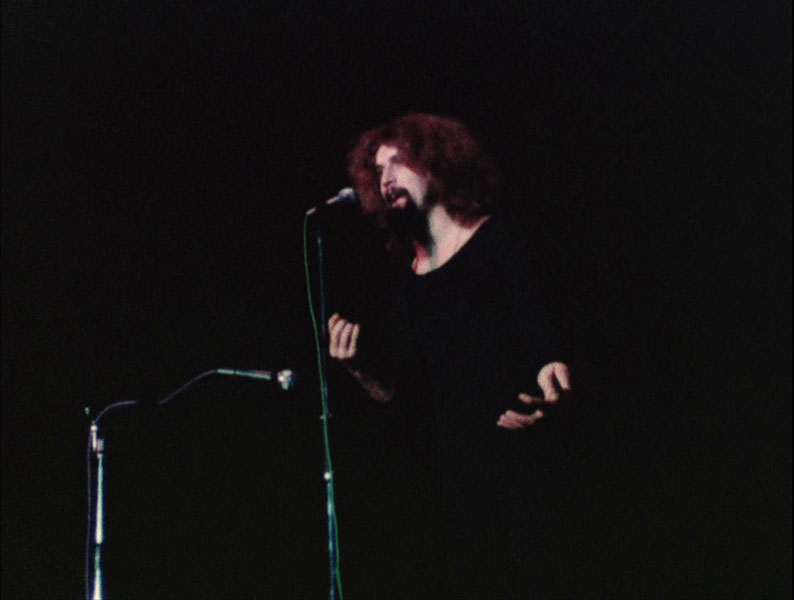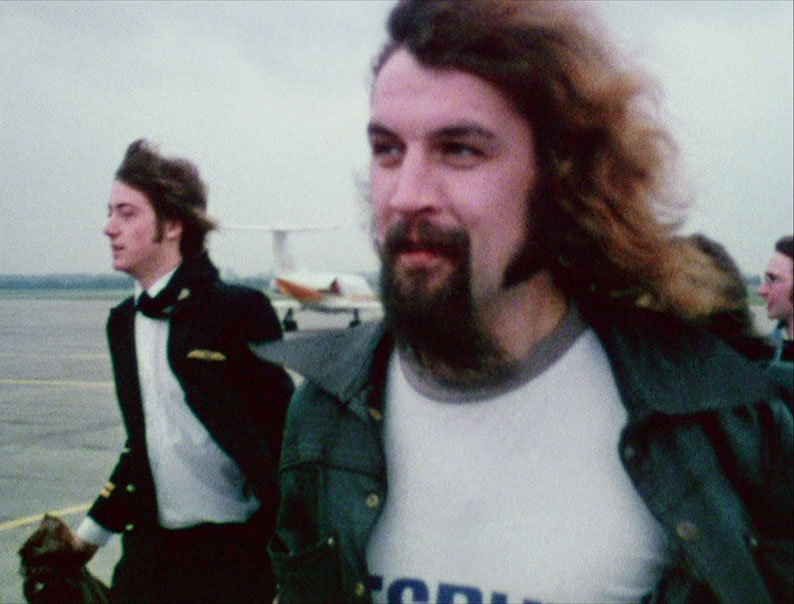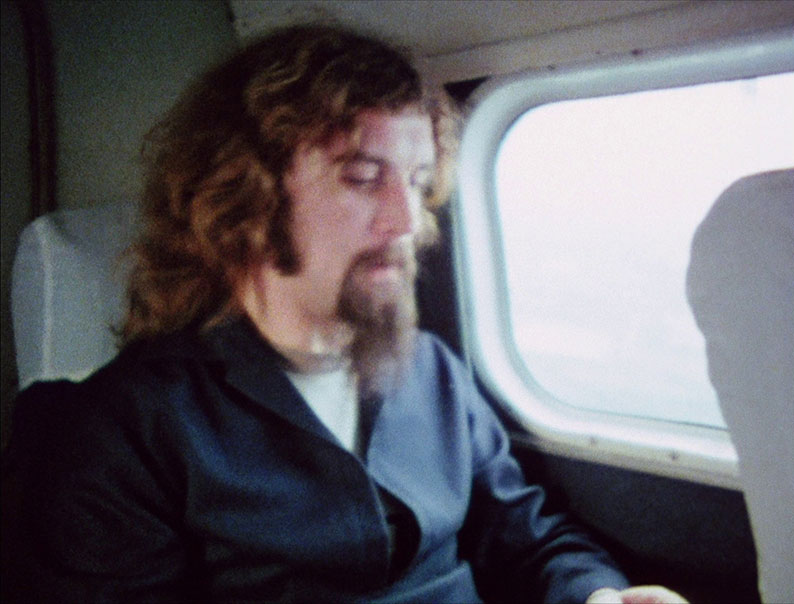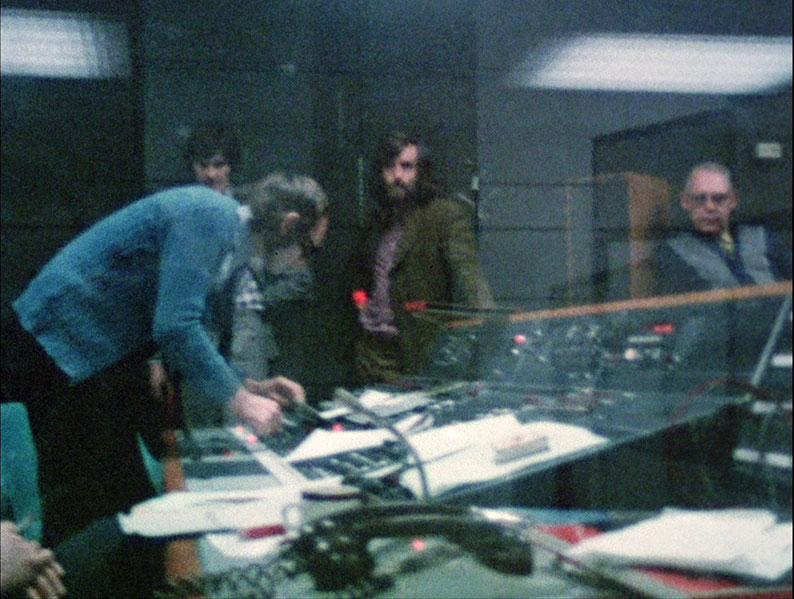|
Big Banana Feet is a documentary of Billy Connolly’s tour of Ireland in October 1975, which took in a gig in Dublin followed by two on the same evening over the border at the ABC Belfast. 1975 was a big year for Connolly, a month away from thirty-three at the point we see him. In addition to his increasing fame as a comedian, he had made his acting debut in the Play for Today Just Another Saturday, written by fellow Scot Peter McDougall. (The following year, he was half of the cast of McDougall’s next Play for Today, The Elephant’s Graveyard.) In November, he would be at number one in the UK singles chart for a week with his comic version of Tammy Wynette’s “D-I-V-O-R-C-E”. (Trivia point: it was the number one between David Bowie’s “Space Oddity” and Queen’s “Bohemian Rhapsody”.)
Connolly had certainly paid his dues. Born in Glasgow in 1942, he had left school at fifteen with an engineering qualification but no others. He had taken on a variety of jobs: amongst other as a delivery driver, a shipyard boilermaker, and ten weeks building an oil platform in Biafra. When he returned, he followed his wish to be a folk singer. He started The Humblebums towards the end of the decade, first as a duo with Tam Harvey, then a trio when Gerry Rafferty (whose lasting fame came later as part of Stealers Wheel and the solo hit “Baker Street”) joined, then back as a duo when Harvey left. The band recorded three albums and split up in 1971. Continuing as a solo act, Connolly began to mix his songs with comedic monologues, some of which tested the limits of acceptability – one, called “The Crucifixion”, was widely banned on radio. By this time, he was selling out his gigs and his fame was such that he was invited onto the chat show Parkinson. (He holds the record for most appearances on Michael Parkinson’s show, fifteen.) His stardom increased not just in his native Scotland, but in England, Australia and Canada as well.

Murray Grigor’s film acknowledges the influence of D.A. Pennebaker’s Dont Look Back (1967), which followed Bob Dylan on his tour of England in 1965. Also shot in 16mm (though in colour), Grigor’s film has similar fly-on-the-wall camerawork as Connolly does a round of interviews, is clearly exhausted first thing in the morning in his hotel room, flies to Belfast from Dublin despite fears of bombings in the Northern Irish capital, this being at the height of the Troubles. But the bulk of the film shows him on stage, with a mixture of monologues and comedy songs played on a guitar or banjo. Some of these are parodies of existing songs: as he would do with Tammy Wynette, here he has a go at Kris Kristofferson’s “Help Me Make it Through the Night”.
Although he had sometimes tested the limits of what he might be allowed to say on television, but on stage (and on film, if you were then over fourteen years old) he could be and was ruder. He says in an interview that he doesn’t do much sexual humour, other than a routine about his willy. On the other hand, he’s often scatalogical, with routines about toilets, about farting, about wetting yourself in school. A piece on swearing inevitably includes examples of what he talks about, and he refers to Kenneth Tynan’s infamous “fuck” on live television ten years earlier.
Needless to say, at the time this film was made, Connolly was edgier than he might have been later, particularly as you couldn’t see and hear him at full strength on the small screen. You can see more of him in the Amnesty International Benefit Concert in 1979, captured on film as The Secret Policeman’s Ball, released the same year. Needless to say, he’s been long since surpassed in terms of profanity and explicitness by other comics, and Connolly has made the journey from Young(ish) Turk to establishment figure, being knighted in 2017. It does seem now like the product of another age but, if you aren’t too easily offended, Big Banana Feet retains its charm and is still funny.

Big Banana Feet was originally offered to the BBC for showing, but the scatalogical jokes were a sticking point. At that point, the film existed in a rough cut of around forty minutes. Declining to cut the film, Grigor and co-producer Patrick Higson instead expanded the film to its present length of 77 minutes, adding material which simply wouldn’t have seen the light of a cathode ray tube in the mid-1970s. Blown up from 16mm to 35mm, Big Banana Feet was given a cinema release in 1977. However, the distributor, Brent Walker, re-edited the film against Grigor’s wishes. After that release, the film vanished, with just a standard-definition copy known to exist, with any film materials likely lost with the bankruptcy of the distributor. However, a 16mm copy was held by the Pacific Film Archive, left there by Murray Grigor. It is from that copy, plus another print acquired by a private collector, that Big Banana Feet has been restored as much as possible to its original form, given a cinema reissue and this Blu-ray and DVD edition.
Big Banana Feet is a dual-format release from the BFI, comprising a Region B Blu-ray and a Region 2 PAL-format DVD. This review is from a checkdisc of the former, so any running times quoted are for that version, at 24 frames per second.
The film had a AA certificate on its original cinema release, and it is now a 12A for cinema and 12 for homeviewing. The reason for that is, as you would expect, “infrequent strong language, drug references”. However, at 24:10, Connolly drops a “cunt”. It’s a little muffled, and as you might expect spoken in Connolly’s Glaswegian accent, so I suspect the BBFC examiners missed it, but the BFI’s subtitler didn’t. There is also some strong language in the Murray Grigor/Billy Johnson Q & A among the extras.
It should be borne in mind that this was a 16mm-originated film, likely not shot with any special lighting, so the transfer is notably soft and grainy, and the on-stage sequences are quite darkly lit. However, the verité look is everything, and this is how the film has always looked. The transfer is in the ratio of 1.33:1, which was the native ratio of 16mm. That’s no doubt correct, though anyone seeing this in a commercial cinema in 35mm on its original release would have had it cropped, most likely to 1.75:1.
Big Banana Feet had a mono soundtrack on its cinema release, and that’s rendered as LPCM 2.0 on this disc. While clearly recorded live (maybe there were some tweaks, but I didn’t spot any), the dialogue and songs are as clear as they should be. English hard-of-hearing subtitles are available for the feature and the Grigor/Johnson Q & A, and I didn’t spot any errors in them.
Murray Grigor and Billy Johnson in Conversation (17:47)
Murray Grigor is interviewed by the BFI’s Douglas Weir (also producer of this disc and acquirer of the second print of the film) after the restoration’s premiere at the Glasgow Film Festival. Connolly’s road manager on the Irish tour, Billy Johnson, joins them on stage for part of the time. Grigor observes that different audiences laugh at different parts of the film. He also talks about Brent Walker’s re-editing of the film, removing amongst other things Connolly’s monologue about Ian Paisley calling him a blasphemer. He and Weir talk about the restoration of the film. Johnson talks about how he almost lost Connolly’s famous banana boots, after which the film is named. (They are now kept on display at the People’s Palace in Glasgow.) A question from the audience, rendered as a text caption, asks about the influence of Dont Look Back, which Grigor confirms.

Clydescope (30:42)
A documentary made in 1974 by Murray Grigor, Clydescope takes us up the river starting in Biggar and ending in Brodick. Billy Connolly turns up in various guises as our guide. He’s in more gentle form than he might have been, no doubt because the film’s sponsor (Films of Scotland and the Clyde Tourist Association) required something family-friendly. Visually, Clydescope is quite inventive, including animation, at least one acted scene (Stephen Yardley appears as an English car driver asking Connolly for directions) and black-and-white and sepia archive footage of such as Glasgow Central Station and Sauchiehall Street. There is even some faked archive as the Pierrots of Rothesay remove their masks to reveal – guess who. The narration is by Micheál Mac Liammóir, no less.
BLAST (23:57)
This documentary, made by Grigor in 1975, begins with archive footage, but it’s archive heavily dominated by machinery: trains, cog wheels, typesetting and printing presses. The latter finally produces the word BLAST (in caps), which was the magazine which in 1914 published the manifesto of the Vorticist Movement. Headed by Wyndham Lewis, this was influenced by the Cubist and Futurist movements on the continent and aimed to produce art appropriate for a new age. It also intended young-turkishly to shake up what it saw as the complacency of British society and British art, hanging over from the recently-ended Victorian age. So representation was out, and in was a hard-edged almost mechanical abstraction. However, the founding of the movement was shortly followed by a World War which cast a different light on mechanisation and instead introduced the mechanisation of mass slaughter. Some of the Vorticists were killed in action. The last word goes to Lewis:

Rerelease trailer (1:00)
As it says, with extracts from the film itself presented in 1.33:1 but captions filling the whole wide screen.
Restoration demo (1:39)
This presents scenes from the film with the restored version on the left and the original print on the right in a split screen, showing how washed out this was before the colour was corrected and damage removed.

Booklet
The BFI’s booklet, available in the first pressing only, runs to twenty-four pages. It begins with a piece by Murray Grigor, which begins with his first meeting with Connolly, which led to his featuring in Clydescope. From that came the opportunity to film Connolly’s Irish tour in 1975. Grigor then discusses the BBC’s reaction to the film, which led to its being expanded to feature length with mixed results when the distributor got hold of it.
Claire Buchanan contributes “These Boots Are Made for Talking”, giving the background to the Irish tour. Connolly had been on the road for seven weeks before he landed in Ireland, and the situation was tense due to the Miami Showband Massacre of 31 July 1975, an attack by the Ulster Volunteer Force which left five dead, including three of the Miami Showband cabaret act. Johnny Cash had cancelled a visit to Ireland as a result, but Connolly went ahead. He was circumspect about including politics in his act, feeling that the people of Belfast wanted a respite from that. He still had to deal with hecklers in the audience. Buchanan goes on to discuss the restoration of the film, which took four years as the pandemic didn’t help.
“Clydebuilt: Ships, Masculinities and Movies” is by David Archibald. At its height, Glasgow produced a quarter of the world’s shipping. The industry has often featured on film, for example the Oscar-winning short documentary Seawards the Great Ships (1960) and, for television, The Bowler and the Bunnet (1967), the sole directing credit of Sean Connery, which dealt with industrial action in the shipyards. “Clydebuilt”, Archibald says, also came to characterise a particular image of the Glaswegian male, as opposed to the rural and more sentimental “Tartan and Kailyard” picture of Scotland – a world of hard-drinking hard men, often violent, but fired by a sense of social justice. This segues into a profile of Billy Connolly, from his beginnings as a singer to his success as a comedian, which was becoming mainstream by the time Big Banana Feet was made. Archibald sees Connolly as representing a side of Glasgow masculinity, bringing in the two Peter McDougall Plays for Today. The piece then goes on to discuss Murray Grigor’s role in presenting these and other aspects of Scottish culture in his documentary career.
After a one-page list of film credits, notes on and credits for the extras, Douglas Weir contributes “Preserving Bananas Through Distribution”, two pages which began by talking about how films can easily become lost when supposedly everything is available. Big Banana Feet follows Dance Craze and The Appointment as a film which had been unseen for many years and original materials often no longer exist. But thanks to the BFI, they are now back in circulation.
Billy Connolly’s fame was peaking in 1975, when Big Banana Feet was shot. Nowadays he’s achieved National Treasure status, with a knighthood to prove it. The film, unavailable for many years and now restored, shows him in action, as ever well-presented by the BFI.
|